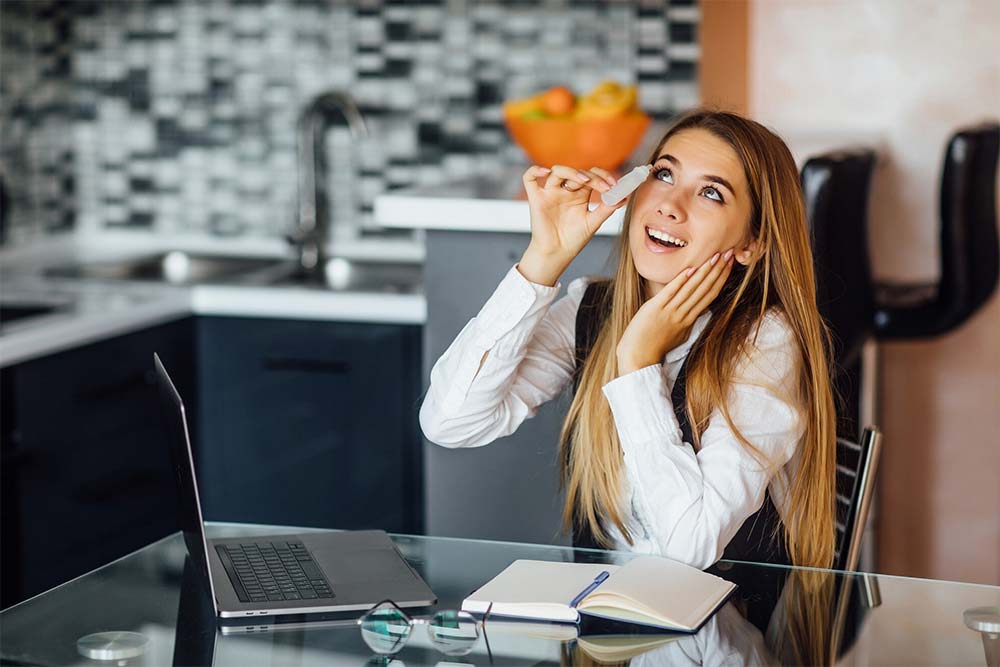When it comes to caffeine, like many things, moderation is key. Yes, the chemicals in coffee (like caffeine) cause your pupils to dilate, but they’re also alerting your brain, which is needed for vigilance and memory. So, if you’re having trouble sleeping, avoid caffeine after 3 p.m. or bedtime, as that can throw you off.
Caffeine is beneficial for a person’s eye health. While it is natural to wonder how caffeine affects a person’s eyes, more and more recent studies have demonstrated that caffeine, when consumed in moderation, is beneficial for eye health. Research suggests caffeine may help protect the eye from permanent damage from certain ultraviolet lights. Caffeine may also help lubricate the eye, which may help those with dry eyes. Caffeine may help delay the progression of age-related macular degeneration.
Caffeine causes eye dryness, but drinking plenty of water can help prevent the eyes from becoming dry. People with a history or family history of dry eyes are more susceptible, as are those who constantly work in dry environments. So, if you experience dry eyes, it may be better to avoid caffeine. If you’re looking for additional treatment options for Dry Eye, you can check out clinical trials for dry eye at Power.
Does caffeine can make a Dry Eye worse?
Caffeine is the most widely used stimulant in the world. It is a common reason for a consultation with the pharmacist, and most people with dry-eye syndrome consume caffeine. However, researchers are still investigating the possible links between caffeine consumption and dry-eye syndrome.
According to research, drinking too much caffeine may worsen dry eye symptoms. Researchers reviewed 17 studies involving 1,746 people. In all, 2.5 percent of the participants reported having dry eye symptoms. However, the study found that people who reported taking more than 500 milligrams of caffeine a day were more likely to report dry eye symptoms.
The researchers suspect caffeine induces fluid outflow from the eye, making the eyes feel drier. However, caffeine is present in many other beverages, such as coffee, tea, and chocolate. Therefore, the researchers say, a caffeine-free diet may be the best course of treatment.
Caffeine can be the cause of dry eye symptoms. Caffeine helps stimulate your body’s release of chemicals called neurotransmitters, which control our moods, sleep, and energy levels. Some people experience fatigue, difficulty sleeping, and restlessness after drinking coffee. Other patients experience dry eye symptoms after drinking coffee. Increasing the intake of caffeine can increase dry eye symptoms.
What to do of a Person with Dry Eye?
Here are some important suggestions that could help your eyes. The first step is to address any health condition that may be contributing to dry eye. Diminishing dry eye symptoms and increasing tear production often requires a combination of sophisticated tear-regulating medications and lifestyle changes. Additionally, there are several natural methods you can use to help support your tear production.
The dryness of the eye is a symptom of many diseases and disorders. The exact cause of the dryness of the eye is not important. Dry eye treatment generally involves the use of artificial tears or ointments. Some patients may get relief from eye drops, small, frequent amounts of lubricant that moisten the surface of the eye.
Dry eyes may occur at any age. They usually are a symptom, not a disease. Over 90% of cases are caused by aging. Dry eye symptoms can include dryness, redness, stinging or burning, scratchiness, grittiness, and a tingly feeling. A Dry Eye can be cured in natural ways. If you treat your dry eye problem with natural remedies, you can get rid of this problem.
What Medical Treatment to use for a Person with Dry Eye?
The dry eye treatments available include drops, ointments, and lid scrubs. The oil-soluble drops dissolve in the tear film, giving the eye’s surface a coating of fats. This prevents the evaporation of tears. In contrast, the nonoil-soluble drops attach to the eye’s surface, preventing evaporation.
The ointments like cyclosporine and tacrolimus are ointments that reduce inflammation. The lid scrubs are gentle products that remove debris from the eyelids, including meibomian glands, which produce oil that keeps the surface of the eye moist.
Dry Eye Treatment is done by the ophthalmologist. Dry eye is a chronic, recurring eye condition in which the eyes do not produce adequate tears or the tears are not of a quality that is sufficient to keep the eye lubricated. Dry eye treatment consists of a variety of medications, ointments, and eyedrops. Some forms of therapy treat the underlying condition that causes dry eye, such as Meibomian gland dysfunction, allergic conjunctivitis, and certain autoimmune diseases. Other forms of therapy treat the symptoms of dry eye, such as artificial tears and punctual plugs.
The dry eye treatment used to address a person’s dry eye symptoms depends on the severity of their dry eye symptoms. This diagnostic tool can also easily measure a patient’s tear production. Mild dry eye symptoms are typically treated with artificial tears, lubricating eye drops, and eyedrops that increase tear production. Surgery may be recommended in severe severe cases to interfere with a person’s quality of life.

